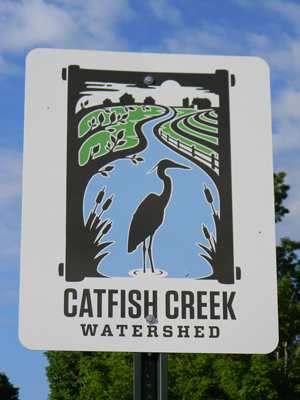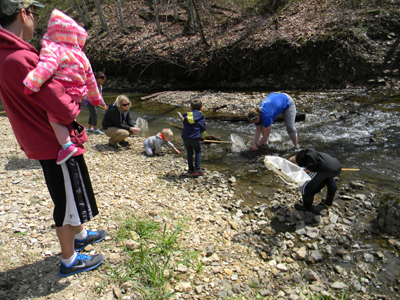Watershed Wednesday: Working Together for Common Goals
posted
on Wednesday, January 13, 2016
Note: This article is the second in a month-long series of Watershed Wednesday blog posts about a watershed approach for Iowa. Click here to view other articles in the series.
 |
| Photo courtesy of Catfish Creek Watershed Management Authority and Applied Ecological Services. |
In a watershed framework, urban and rural residents work together to solve multi-faceted water quality issues to achieve common goals. The Catfish Creek watershed plan is a prime example of this philosophy in action.
Efforts to improve Catfish Creek started nearly a decade ago when a group of Iowans came together to protect a prized trout stream. Since then, urban and rural residents have been working together to identify and solve problems, and in the process, they are creating pride in their shared watershed identity.
Dubuque, Peosta, Asbury and Centralia share the 57-square mile Catfish Creek Watershed in Dubuque County with extensive agricultural land and popular outdoor attractions. The area is susceptible to flooding, and all five tributaries of the creek exceed recommended water quality limits for nitrogen, phosphorus and sediment. Pollution from bacteria is also a problem in many stream segments.
Efforts to address Catfish Creek’s challenges got off the ground with grant support from the Iowa Department of Natural Resources 319 Program and the state Watershed Improvement Review Board. When that three-year project ended, the partners knew there was still a lot of work to do. That led them to establish one of the state’s first Watershed Management Authorities, which was then selected to receive Iowa Department of Economic Development funding to create a watershed plan.
The resulting 316-page Catfish Creek Guide for Protecting and Restoring Watershed Health was completed in 2014 with a 30-year timeline. The plan is a tool for education and outreach, as well as a blueprint for action by municipalities, developers, farmers and homeowners.
The Catfish Creek Watershed Management Authority’s (CCWMA) leaders cite sustainable funding as one of their most significant challenges. WMAs were established by the Iowa legislature without a dedicated source of support. To survive, they must be creative.
For now, Catfish Creek is able to employ coordinators Eric Schmechel, an urban conservationist with the Dubuque County Soil and Water Conservation District, and Dean Mattoon, with the City of Dubuque. They have helped secure assistance from many partners, including colleges in Dubuque and the University of Iowa Flood Center, which has conducted monitoring to help identify where to focus limited resources.
The CCWMA is also starting a unique effort that will leverage $1.4 million through the State Revolving Loan Fund to cost share urban and rural conservation practices prioritized in the plan. They plan to start with practices that can provide multiple benefits to get the best return for limited resources, such as stabilizing stream banks, controlling livestock access to streams, planting buffers, urban composting, and restoring soil quality.
Through it all, the WMA’s leaders have worked to reach rural and urban stakeholders. “One of our first actions was to send letters out to landowners to get permission to walk their stream reaches, and we invited them to come along and share stories about their land,” said Mattoon. “Many of them took us up on that and it was great to hear their pride in the places they own and farm… We have also worked to engage developers, sometimes bringing rural participants to our meetings and conferences. That has helped people understand that our problems and solutions are often linked.”
 |
| Photo courtesy of Catfish Creek Watershed Management Authority and Applied Ecological Services. |
Catfish Creek’s coordinators say they are seeing good participation from both urban and rural residents, and interest seems to be growing. Even something that sounds simple like creating an attractive logo has helped bring people together, said Schmechel. “People want the Catfish Creek sign in their back yard, and they are wearing our t-shirts and hats,” he says. “The logo is identifiable, and it seems to help people appreciate their connection to the watershed and the community of people trying to protect it.”
By adopting a statewide watershed framework that implements the type of approach being taken in the Catfish Creek Watershed, Iowa can achieve the landscape scale change necessary to significantly improve water quality, benefiting our communities and economy. The Iowa Environmental Council applauds the partners working in Catfish Creek for their exemplary work. We look forward to the day when projects like this are the norm in our state.
Learn more at catfishcreekwatershed.org
- conservation
- water quality
- watershed wednesday